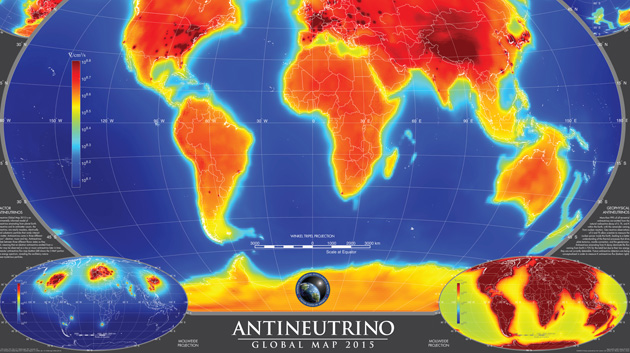

A team of researchers led by scientists at the National Geospatial-Intelligence Agency (NGA) published a new map on September 1 that characterizes the Earth’s radioactivity. The Antineutrino Global Map 2015 (AGM2015) can inform the strategic placement of detectors that aid in identifying undeclared nuclear reactors.
The neutrino and its antimatter cousin, the antineutrino, are subatomic particles that are produced by stars of all types, including the Sun, as well as Earth’s atmosphere, supernovae, nuclear reactors and radioactive materials. AGM2015 is the first model of the Earth’s natural and manmade antineutrino flux, using open source geophysical data sets and publicly available international antineutrino detection observational data.
The research team is composed of neutrino physicists and geophysicists from the National Geospatial-Intelligence Agency, the University of Hawaiʻi, Hawaiʻi Pacific University, the University of Maryland and a Virginia-based company known as Ultralytics, LLC.

“This antineutrino map may mark the start of a new scientific subfield,” said UH Professor John Learned. “This map is similar to making the first map of North America after Columbus arrived, in that those early explorers had fragmentary information from a few scattered outings and used it to create a comprehensive tool for many others.”
“John’s analogy is particularly relevant to the natural antineutrino flux, which has very large uncertainties compared with the manmade antineutrino flux,” added Hawaiʻi Pacific University Professor Stephen Dye. “AGM helps guide the quest to chart what keeps our planet warm inside.”
The map and accompanying research paper are published in Nature’s Scientific Reports. For more information and to download the map, go to the NGA website.
About antineutrinos and geo-neutrinos
Learned was part of the team that discovered oscillations and mass in neutrinos in 1998. Antineutrinos were first detected as emissions from nuclear reactors in the mid-1950s two decades after their existence was proposed. More than 99 percent of all terrestrial antineutrinos come from within the Earth, with the remainder coming from nuclear reactors. The detection of antineutrinos from nuclear reactors continues to provide insights into their oscillatory behavior and potential future applications for nuclear nonproliferation.
The study of geo-neutrinos, needed to support reactor detection, is also a gateway to meaningful geologic research into the Earth’s heat sources and geodynamics. Geophysical antineutrinos, or geo-neutrinos, are produced by naturally occurring radioisotopes in the Earth, revealing information about the planet’s interior. Geo-neutrino measurements are essential in characterizing the Earth’s radiogenic power across geologic time and in improving our understanding of planetary formation processes in the early solar nebula.
The authors expect to release periodic updates to the original AGM2015 as future oscillation measurements, crust/mantle model advancements, and ongoing construction and decommissioning of nuclear reactors will eventually change the map.
AGM2015 is a product of NGA’s antineutrino research program. In addition to mapping out the Earth’s antineutrino flux, NGA and UH have developed a small prototype antineutrino detector that is currently being tested at the National Institute of Standards and Technology in Gaithersburg, Maryland.
—By Kelli Trifonovitch

